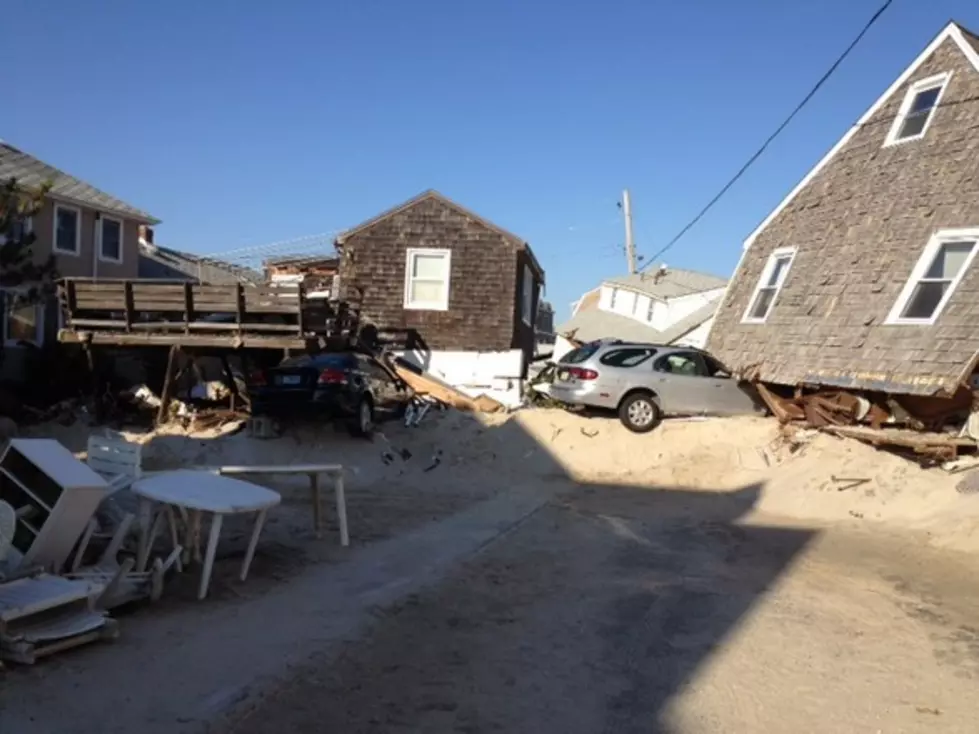
4 years later obstacles from Sandy remain: Is NJ prepared for the next Superstorm?
Members of groups formed in the aftermath of Superstorm Sandy four years ago this Saturday said they haven't seen much progress following the devastation that displaced thousands in the shore-area alone.
Stop FEMA Now founder George Kasimos and Joe Mangino with New Jersey Organizing Project discussed the obstacles that remain and whether the state is prepared for future storms on WOBM-AM's "Townsquare Tonight" program on News Talk 1160 and 1310.
Many families haven't returned home, there's still contractor fraud, unresolved flood claims and tons of frustration.
Mangino said that while he expected the recovery process to be a 10 year project, he never anticipated a battle with insurance companies to get money for damaged homes or issues that arose with the states RREM grant program.
"The state's rebuilding program, that was an absolute nightmare, not only for me, but for thousands of other people to get into and to stay into, because the incompetence was on a scale I've never seen and have never encountered. Those were two huge steps, and then just the day to day struggles for their families to try and live their life while rebuilding their life,"said Mangino.
Fighting for rental assistance and for transparency from the state in dispersing the federal funding it received also were issues that left storm victims seeking answers with no real place to turn, according to Mangino.
Kasimos added to that by saying that when FEMA intervened, the agency acted like it was the first time there was a flood in America. He recently returned from a visit to Louisiana, and said the scenario is being repeated there, as well as in the Carolina's and Florida.
Not having a specific guideline from FEMA to follow during the rebuilding process and lack of knowledge about the process from federal, state and municipal lawmakers also has been frustrating for Kasimos, and others who he said rebuilt quickly and were later told their flood insurance was increasing to $30,000 a year and that they'd have to raise their homes.
"People whose homes were actually pushed off their foundation into the bay, a 2,000 square foot home, they got $30,000 and they have a $250,000 policy. Four years later, today, four years after Superstorm Sandy, people are still waiting a fair claim. 20,000 people reopened up their claim. Unprecedented, in the history of insurance, let alone flood insurance," said Kasimos. He added, "It is a shame what our federal government has done to policy holders."
Mangino just received his check from FEMA this week after reopening his claim. "The money I got this week had a lot more value a few years ago. I may have made different decisions, and that goes for everybody who was affected," He said. Magione spent $70,000 in rent while waiting for his claim.
A retired veteran called into the show and shared that he lost $95,000 in flood insurance money to rebuild his home to a contractor who he later discovered had a criminal record. Although he ended up obtaining a grant from the Department of Community Affairs, he still had to take out a bank loan and now has a mortgage again.
Mangino pointed out that when a person falls victim to a contractor, the entire rebuilding process stops.
"And they have no idea when it's going to start again. It mostly like won't start until criminal charges are filed against that contractor," said Mangino.
That starts the cycle again of having to pay rent and a mortgage while waiting.
Congressman Tom MacArthur (R-3) called in at the end of the program and assured that helping those still not getting a fair shake is high priority when FEMA's National Flood Insurance Program is reauthorized next year.
"I want to make sure that this program is reformed and there's better accountability, that they can never do this kind of thing again," said MacArthur.
As far as how prepared New Jersey is for future storms, Mangino said what's being done now is a band-aid approach and that the state has no plan to deal with sea level rise or climate change.
"So, when you're not even allowed to say the words climate change in Trenton, how do you expect anything to get done, and it's not getting done, and we're going to suffer. Families like mine that are invested in our community, that mitigated our property by raising our home there, taking all these steps because we want to be here, and the state is providing no oversight, no guidance, there is no strategy," Magino said.
Kasimos said he has been pushing for sea gates similar to what was installed in New Orleans to prevent back bay flooding from Barnegat Light, Mansquan and Egg Harbor Inlet. He said the sea gates along with the dunes offer the best protection and would result in FEMA having to redo the flood maps which could lead to decreased flood insurance premiums.
In the future, Magino said he'd like to see funding in place to mitigate prior to a disaster, so people can be prepared, instead of reacting after a storm hits. Kasimos added that for every dollar spent on mitigation, it's like spending $4.00 after a storm.
Mangino and Kasimos were scheduled to testify with other Sandy victims in Trenton Thursday before an Assembly panel on hurricane-related issues and whether New Jersey is prepared.
More From 92.7 WOBM









